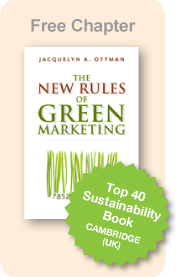Jacquie Ottman's
Green Marketing Blog
CFLs: It Takes a Team to Market a Lightbulb
July 16, 2008 by assistant
CFLs have become the quintessential example of a mainstream green product. As proof, as of October of 2007, Wal-Mart announced that it had surpassed its goal of selling 100 million CFLs by the end of 2007, three months ahead of time. However, this accomplishment was not so easily attained. The current success of CFLs is due to the innovation and commitment of a virtual “village” of manufacturers, designers, and marketers.
Remember those early CFLs? Too many consumers were reluctant to pay $15 versus 75 cents for an incandescent, despite promises of hefty savings over the life of the bulb. Even Philips’ attempt to appeal to deep green consumers with its “Earth Light” brand failed to ignite interest. But times—and the lamps—have changed. Advances in technology and clever design have led to products like Philips’ Marathon. It offers a fast start time, incandescent shape to accommodate any harp, and better light quality, all for about three dollars.
An important factor in the success of Philips’ Marathon bulb is its market positioning. It leverages CFLs’ real appeal to the mass consumers – they don’t have to be changed as often and they save money over the life of the bulbs. Messages on their packaging highlight Marathon’s “long lasting” benefits and, to get consumers over the premium hump at the point of sale, promise an estimated $26 in savings. To underscore credibility, Marathon package graphics sport the EPA’s Energy Star logo as well as the trusted Philips brand name.
Even though CFLs represent a huge step forward in energy efficiency, all compact fluorescent bulbs including the Marathon bulb, contain a tiny, yet highly toxic amount of mercury. Mercury can cause mental instability, a change in personality, and damage to the liver and kidneys. Once in landfills, it can contaminate underground water supplies. Indeed, many states prohibit the disposal of CFLs in regular trash. Even without laws, the value of this mercury, as well as the energy embodied in CFLs, behooves lamp manufacturers to collect the bulbs for recycling. Retailers can help.
In states with bans on dumping CFLs, consumers have had to take the bulbs to special household hazardous waste collection facilities. Now, recycling has become easier. In 2008, Home Depot, the nation’s second largest retailer, began a CFL take-back program in all of its 1,973 stores in the United States. With approximately 75 percent of the nation’s homes within 10 miles of Home Depot stores, it’s the most widespread CFL recycling program in the U.S.
Click here to join our mailing list.



 ShareThis
ShareThis

